Experimental Highlights - 2014
August
NIF Tests Two New Target Designs
NIF experiments in late August tested the performance of two alternative target designs, one with an alternate capsule ablator and another with modified hohlraum geometry.
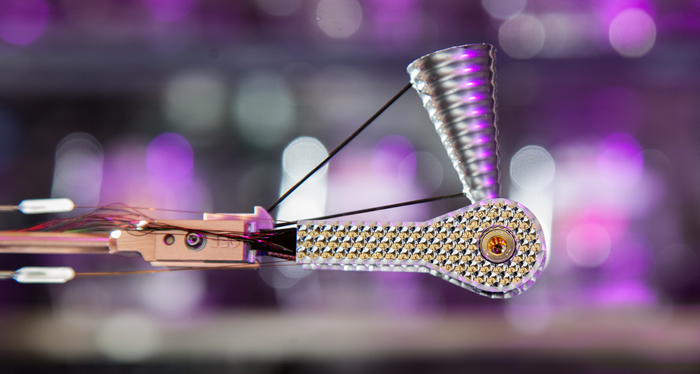 Beryllium capsule in the hohlraum of a keyhole shock-timing target. Keyhole experiments measure the strength (velocity) and timing of the shock waves from the laser pulse as they transit the capsule. The viewing cone for the Velocity Interferometer System for Any Reflector (VISAR) diagnostic, shown mounted above the hohlraum, is inserted through the side of the hohlraum wall and into the capsule. (Credit: Jason Laurea)
Beryllium capsule in the hohlraum of a keyhole shock-timing target. Keyhole experiments measure the strength (velocity) and timing of the shock waves from the laser pulse as they transit the capsule. The viewing cone for the Velocity Interferometer System for Any Reflector (VISAR) diagnostic, shown mounted above the hohlraum, is inserted through the side of the hohlraum wall and into the capsule. (Credit: Jason Laurea) The first experiment in a series using a target capsule (ablator) composed of beryllium (Be) was conducted on Aug. 29-30. The keyhole, or shock-timing, shot provided the first data for a campaign evaluating the performance of beryllium capsules in high-foot (high initial laser pulse) experiments. The results also will evaluate how the Be ablator affects laser-plasma interaction and backscatter, and will provide the first shock-timing data to benchmark simulations for beryllium capsules. The Be ablator campaign is led by the Los Alamos National Laboratory (LANL) inertial confinement fusion (ICF) program in close collaboration with LLNL scientists and with support from the NIF Operations Team.
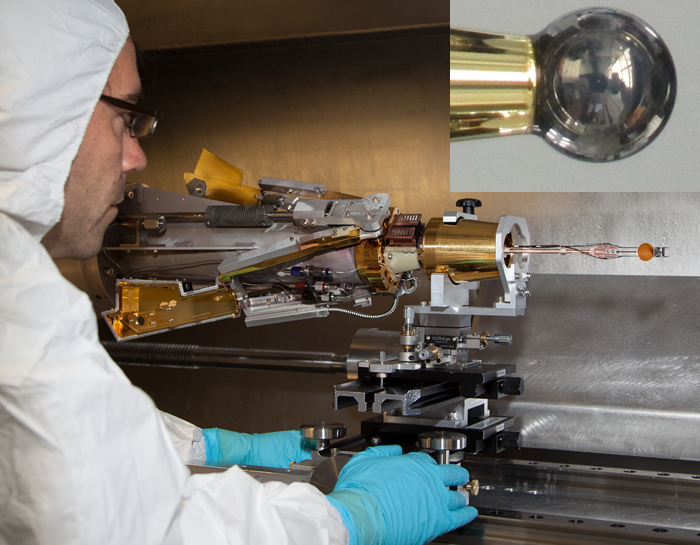 Cryogenic Systems Operator Eric Mertens installs the first NIF beryllium capsule target in the target positioner (TARPOS) for the Aug. 29-30 LANL ICF campaign shot. (Inset) The beryllium capsule subassembly mounted on the VISAR keyhole cone. This was the first shot in the development of a promising new ablator, spearheaded by the LANL ICF team, that has been in the works at LLNL and LANL for more than a decade.
Cryogenic Systems Operator Eric Mertens installs the first NIF beryllium capsule target in the target positioner (TARPOS) for the Aug. 29-30 LANL ICF campaign shot. (Inset) The beryllium capsule subassembly mounted on the VISAR keyhole cone. This was the first shot in the development of a promising new ablator, spearheaded by the LANL ICF team, that has been in the works at LLNL and LANL for more than a decade. In the experiment, all 192 NIF beams delivered 561 kilojoules of ultraviolet light to the drive hohlraum in a 12.2-nanosecond laser pulse with 288 terawatts of peak power. Good diagnostic data were acquired; very low stimulated Brillouin and Raman scattering was measured. Excellent pole and equator VISAR data was obtained during both the foot and the main laser pulse, and good shock symmetry was observed.
Target capsules in previous NIF experiments have been made of germanium, silicon-doped plastic, or undoped diamond-like high density carbon (HDC). ICF researchers believe beryllium could present a more attractive ablator material option. The low opacity and relatively high density of Be may lead to higher rocket efficiencies, 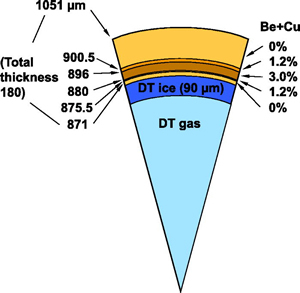 Structure of the NIF “Revision 6” beryllium capsule. The capsule has an outer radius of 1,051 microns and consists of a 180-micron-thick layer of graded copper (Cu)-doped Be ablator, a 90-micron-thick layer (about 0.2 milligrams) of deuterium-tritium (DT) ice, and a spherical volume of DT gas. The ablator layer comprises five sublayers (from outside in): an undoped 150.5-micron layer, a 1.2-percent doped 4.5-micron layer, a 3-percent doped 16-micron layer, a 1.2-percent doped 4.5-micron layer, and an undoped 4.5-micron layer.giving a higher fuel implosion velocity for a given x-ray drive; and to higher ablation velocities, providing more ablative stabilization and reducing the effect of hydrodynamic instabilities on implosion performance. Be ablator advantages provide a larger target design optimization space and could significantly improve NIF’s experimental margin for ignition.
Structure of the NIF “Revision 6” beryllium capsule. The capsule has an outer radius of 1,051 microns and consists of a 180-micron-thick layer of graded copper (Cu)-doped Be ablator, a 90-micron-thick layer (about 0.2 milligrams) of deuterium-tritium (DT) ice, and a spherical volume of DT gas. The ablator layer comprises five sublayers (from outside in): an undoped 150.5-micron layer, a 1.2-percent doped 4.5-micron layer, a 3-percent doped 16-micron layer, a 1.2-percent doped 4.5-micron layer, and an undoped 4.5-micron layer.giving a higher fuel implosion velocity for a given x-ray drive; and to higher ablation velocities, providing more ablative stabilization and reducing the effect of hydrodynamic instabilities on implosion performance. Be ablator advantages provide a larger target design optimization space and could significantly improve NIF’s experimental margin for ignition.
An optimized Be ignition target design known as “NIF Revision 6” takes advantage of knowledge gained from recent NIF experiments, including more realistic levels of laser-plasma energy backscatter, degraded hohlraum-capsule coupling, and the presence of cross-beam energy transfer. “The first NIF Be target experiments will study the associated energy backscatter, hohlraum-capsule coupling, Be grain and imperfection effects on the capsule performance, and thereby benchmark the design work and confirm experimentally the Be ablator advantages,” said Andrei Simakov, a lead LANL researcher.
The Be capsules are made of inner and outer layers of pure beryllium with three thin intermediate layers of beryllium alloyed with a small percentage of copper for greater capsule mass; the total thickness is about 150 microns. The capsules are fabricated in batches of 15 over two weeks of 24-hour-per-day machine operation, including set-up times, in LLNL’s Bldg. 298 target development facility.
Joining Simakov on the experimental campaign are LANL colleagues John Kline, Douglas Wilson, Austin Yi, Natalia Krasheninnikova, George Kyrala, Richard Olson, Theodore Perry, and Steven Batha, and LLNL’s Peter Celliers, Daniel Clark, Bruce Hammel, Bernard Kozioziemski, Michael Marinak, Andrew MacKinnon, Nathan Meezan, Jose Milovich, Joseph Ralph, Harry Robey, Jay Salmonson, and John Edwards.
“This experiment represents a very significant new facility capability that was put in place,” said NIF Operations Manager Bruno Van Wonterghem. “The NIF Target Operations and Radiation Control teams worked safely and diligently through the first target and target diagnostic recovery activities in full radiation and beryllium contamination protocol, including respirators and personal air samplers,” he said. “The good news is that initial indications are that all swipes show very low levels of Be, well below the release level of 0.2 micrograms per 100 square centimeters. Be air samples were well below the action level.
“This bodes well for both Be and high-Z shots (experiments using high-atomic-number materials),” Van Wonterghem said. “These first data need to be confirmed in subsequent shots and future Be shots. Once validated over a statistically relevant range, controls will be adjusted to these findings.”
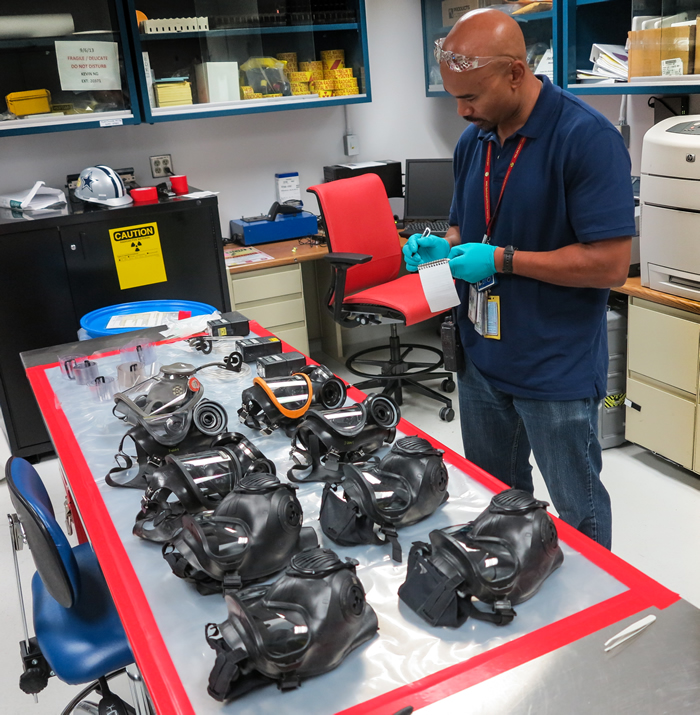 Radiation Control Technician Brian Daniels surveys respirator masks in the Hazardous Materials Management Area radiation lab. The use of dispersible beryllium targets requires respiratory controls to process Target Chamber systems such as diagnostic instrument manipulators and target positioners.
Radiation Control Technician Brian Daniels surveys respirator masks in the Hazardous Materials Management Area radiation lab. The use of dispersible beryllium targets requires respiratory controls to process Target Chamber systems such as diagnostic instrument manipulators and target positioners. On Aug. 23, the NIF Team completed the first high-foot (high initial laser pulse) keyhole shock-timing experiment using a gold-boron-coated rugby-shaped hohlraum. The plastic target capsule was filled with a mixture of helium and neon to reduce laser-plasma instabilities. The results will be compared to cylindrical hohlraums.
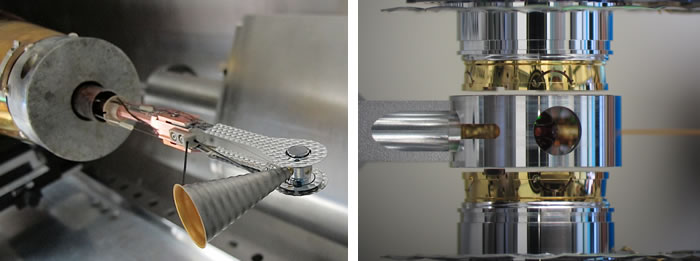 (Left) The rugby-shaped hohlraum keyhole target. (Right) A rugby-shaped hohlraum in the thermomechanical package during final assembly in Bldg. 381.
(Left) The rugby-shaped hohlraum keyhole target. (Right) A rugby-shaped hohlraum in the thermomechanical package during final assembly in Bldg. 381. Experiments using hohlraums shaped like rugby balls began on NIF in March of this year in collaboration with CEA, the French Alternative Energies and Atomic Energy Commission. Rugby-shaped hohlraums are being tested to determine if they can improve drive symmetry control on the target capsule. Compared to standard cylindrical hohlraums, rugby-shaped hohlraums increase the volume around the fuel capsule, making it easier for the laser beams to propagate without increasing the overall area of the hohlraum and the energy required to drive it.
In experiments performed on the OMEGA Laser Facility at the University of Rochester comparing rugby and cylindrical gas-filled hohlraums driven by high-contrast laser pulses, the rugby-shaped hohlraums showed nearly 20 percent more x-ray drive energy than standard cylindrical hohlraums, and the high-performance design of the capsules (both cylinder and rugby) provided nearly 20 times more deuterium neutrons than in any previous OMEGA hohlraum campaigns.
First ARC Stretched Pulses Fired Into Compressor Vessel
On Aug. 7, the Advanced Radiographic Capability (ARC) Team produced the first temporally compressed pulses on the NIF when they propagated low-energy pulses all the way through the main laser and beam transport system and into and through ARC Compressor Vessel 1. The team diagnosed the compressed pulses using the ARC Diagnostics Table in Switchyard 2.
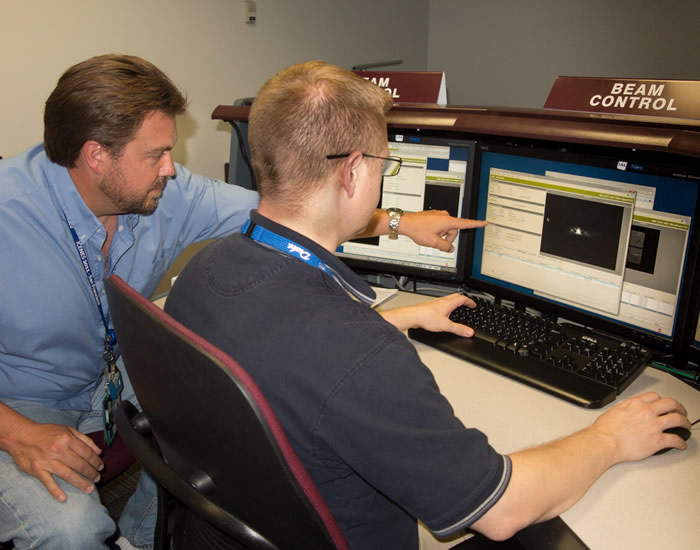 ARC engineer Ron Sigurdsson (left) and beam control system operator Daren Hart view the image of the first light from the ARC regenerative amplifiers to reach the ARC diagnostic table temporal diagnostics.
ARC engineer Ron Sigurdsson (left) and beam control system operator Daren Hart view the image of the first light from the ARC regenerative amplifiers to reach the ARC diagnostic table temporal diagnostics. The ARC petawatt laser system is designed to achieve extreme laser intensities through chirped-pulse amplification: an ultrashort laser pulse, only picoseconds or femtoseconds (10–12 to 10–15 seconds) long, is first stretched in time to reduce its intensity. The pulse’s frequency content is distributed in time to create a nanosecond-long (10–9 second), frequency-swept (chirped) pulse that can be safely amplified without generating intensities above the damage limit of laser glass and optics. After amplification, the chirped pulse is passed through an arrangement of diffraction gratings (pulse compressor) to undo the frequency sweep and re-create the initial short pulse, producing a high-energy, high-power laser pulse which will be used to take x-ray images of NIF implosions and other high-energy density physics processes with tens-of-picosecond temporal resolution.
The ARC team received kudos for working through many challenges to achieve this milestone.



